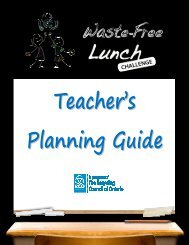waste audit instructions and lesson plan - Waste-Free Lunch ...
waste audit instructions and lesson plan - Waste-Free Lunch ...
waste audit instructions and lesson plan - Waste-Free Lunch ...
You also want an ePaper? Increase the reach of your titles
YUMPU automatically turns print PDFs into web optimized ePapers that Google loves.
2. Do not put reusable lunch boxes or containers into the bag with the lunch <strong>waste</strong>. If youwould like to provide a visual reusable container demonstration, label each student’s lunchbag <strong>and</strong> containers with the student’s name <strong>and</strong> classroom. Select a separate area (e.g.table) for reusable items such as lunch boxes. For health <strong>and</strong> safety purposes, this must beseparate from the <strong>waste</strong>. Collect the reusable containers <strong>and</strong> observe the differencebetween the reusable containers <strong>and</strong> the <strong>waste</strong>.3. After lunch, each class will bring their bag of lunch <strong>waste</strong> material to a designated locationwhere the school lunch <strong>audit</strong> will occur.4. Spread the tarp or plastic sheet out in a suitable space – well ventilated <strong>and</strong> room forstudents to move around the sorting sheet.5. Use labels/signs to create separate sections for items on the tarp/plastic sheet. Make surespace is left for the unsorted <strong>waste</strong>. Briefly explain the meanings of the different categories.6. Tip each classroom’s lunch <strong>waste</strong> bag or container onto the sheet.7. Select students to sort items (using gloves <strong>and</strong> tongs) into categories according to their finaldestination (l<strong>and</strong>fill/garbage, recyclable or compostable).Note: If there is no recycling program, organics collection or in-school compost system, itmay be useful to use the ‘compostable’ category as a way of identifying a future classroomor school project to manage food scraps. Classrooms that do not currently have a recyclingor organic collection service should simply complete the <strong>audit</strong> exercise <strong>and</strong> record results asif there are recycling <strong>and</strong> organic <strong>waste</strong> collections available. This will enable the entry to bejudged fairly with others.8. Select students to place each pile in a pre-weighed bag or container <strong>and</strong> weight it. Subtractthe weight of the container. Record all information on the <strong>Waste</strong> Audit Worksheetincluding: weight of <strong>waste</strong> generated, weight of recyclables, weight of compostable material<strong>and</strong> number of student lunches.After the <strong>Waste</strong> Audit1. Select students to collect items in each category <strong>and</strong> dispose of <strong>waste</strong>, recycling, etc asappropriate. Ensure that all reusable items (lunch boxes, lunch bags) are returned to theirowners.2. Clean containers <strong>and</strong>/tarp as appropriate <strong>and</strong> return to storage.3. Make sure all students wash their h<strong>and</strong>s thoroughly before returning to class.



